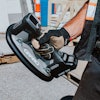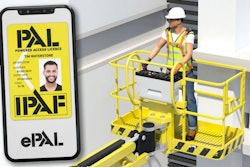
Last year saw the launch of the free-to-use IPAF ePAL Mobile App in the U.S., which features a digital IPAF PAL Card, log book and operator safety guide for users of MEWP and MCWP equipment. Peter Douglas, IPAF CEO and MD, and Søren Brogaard, CEO of Trackunit, the IPAF member firm that helped develop the app, tell Matt Brereton how the app works and why rolling it out worldwide was a key priority.
If you were to stack the 170,000 plastic PAL Cards IPAF issued in 2019 one on top of the other, it would have amounted to a skyscraper about the size of New York City’s One Vanderbilt, which was coincidentally completed in 2019. That’s just one of the reasons why IPAF decided that it needed to bring its globally recognized operator license card into the digital age.
Upon joining IPAF as chief executive and managing director in December 2019, Peter Douglas moved the idea of digitalizing the PAL Card to the top of the agenda. In 2021-22, and despite the severe disruption caused by the coronavirus pandemic, that vision became a reality with the creation and roll out of the ePAL Mobile App.
“Our main aim is to improve safety in our industry,” says Douglas. “But having this app improves sustainability and efficiency in certifying our training program. It has been on IPAF’s agenda for the past four or five years, but with the whole world going digital during the pandemic, we wanted to bring this initiative to the forefront.”
Discussions about the concept and what members wanted to get out of it began in early 2020 before the pandemic struck. The project was put on pause for several months, but gathered pace again through the second half of 2020, as digitalization of all sorts of processes the world over accelerated, ahead of its launch last year.
IPAF worked in partnership with member firm Trackunit, a Denmark-based tracking systems specialist, to develop the app and the platform on which it is based. But—and this is a point that Douglas and Brogaard are keen to stress—IPAF retains ownership of ePAL. Trackunit’s role is to help develop the platform and the app that sits on top of it.
The app, which is available on iOS and Android, is broken down into three main sections: experience, licenses and safety. The licenses section holds a digital version of the PAL Card, which can easily be shared with site managers or anyone else who needs to view or verify it. It also holds details of the training company that provided the operator’s training. The app will have the capability to remind operators when their license is coming up for renewal and prompt them to contact the training center.
Those operators with existing physical PAL Cards are able to enter their details to claim their digital card or simply touch the card to their mobile device to have their digital card created automatically if their phone has near-field communication technology.
The experience section of the app is the one IPAF believes will be of most value to operators and their employers, typically contractors. It replaces the physical log book, which Douglas concedes often ends up getting lost anyway. Users are able to select which type of machine they are working on, before recording the time spent on it. “With the app, it will be much easier for operators to log their time on a particular machine, and that will help to build a better picture of their equipment experience, which they can then show to contractors when they are on-site,” Douglas explains.
To help provide an incentive for operators to log time accurately, the app generates experience points, or "XP," along with anonymized information to show IPAF how frequently different types of machines are being used, how much time is spent on them and in what locations they’re being used. The app also provides an on-the-spot link to IPAF’s accident reporting portal to make for an improved reporting process for recording near misses and accidents accurately, building a richer, more detailed database for IPAF’s expert to analyze.
When it comes to the safety section of the app, there is a feed of tailored safety content aimed at the operator. “It’s informed by all the things we know can go wrong on sites, using our Andy Access posters, technical guidance documents and Toolbox Talks,” says Douglas.
“We also remind people of the importance of doing daily checks, the importance of looking after batteries, of wearing the correct PPE and fall arrest devices—all the things that you would expect to enhance safety and productivity when working at height,” he adds.
Currently, there are around 820,000 valid PAL Cards in circulation, with around 150,000-170,000 due for renewal in any given “normal” year. Operators renewing their license will be asked to download the app to obtain their electronic PAL Card, log book and safety guide.
Brogaard says: “It is the first step on a long journey. We aren’t expecting an industry that hasn’t traditionally worked in a digital way to suddenly go digital overnight. It will take a few years, with the help of manufacturers, contractors and rental companies.”
Douglas is keen to see pre-use checks incorporated into the app in the future, as well as manufacturers’ machine familiarization videos. He also sees potential for a site-survey tool that allows users to determine what machine they should use, which will help cut down on accidents caused because the wrong type of MEWP has been selected.
He is also excited by the environmental benefits of cutting down on all of that plastic, paper log books and the carbon emissions associated with their distribution: “All of it can be put into a neat app on your smartphone— technology that almost everyone has in their pocket.”
Five Key Benefits of the IPAF ePAL App
1) Direct communication of training and safety messages to operators
2) Accurate, up-to-date log book information
3) Reduction in plastic, paper, administrative work and CO2 emissions
4) Simple on-the-spot accident reporting
5) Reliable proof of operator qualifications and experience for site managers
Fostering Collaboration
Douglas wants powered access manufacturers and users to get involved in making decisions about the direction the ePAL App takes. “Trackunit is not helping us to create this for any other reason than that they want to help the industry,” he says.
Brogaard adds, “The platform is being built with IPAF for IPAF. We don’t own the system. We are stepping into this because we see that this has a direct relation to the elimination of downtime for operators, machines and the industry in general. We don’t have an advantage here and other companies have equal access to this platform as we do.”
Likening the platform to open-source software, Brogaard says: “The rental companies play an important role by adapting their ways of working to the app and using it in their training centers to help operators get on board. And contractors can play an important role in elevating this as an important thing for operators to show and to use. It will take time. IPAF made a brave decision to go out and do this.”




















